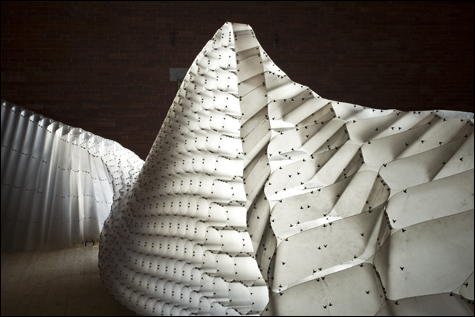
|
‘Art on the Harbor Islands’ | Institute for Contemporary Art | 100 Northern Ave, Boston | On Georges, Lovells, and Spectacle Islands in Boston Harbor | Through October 8 |
Last week, I sat on the top deck of the Harbor Islands Express with parents rubbing suntan lotion into kids seated next to cuddling tourist couples as the boat backed off from Long Wharf and motored southeast, away from downtown Boston and Logan Airport, past the new Institute of Contemporary Art, and out to sea.I was off to see the ICA’s “Art on the Harbor Islands,” temporary site-specific installations by Anna Schuleit, Teri Rueb, Ernesto Pujol, and the architectural firm Office dA on Georges, Lovells, and Spectacle islands in Boston Harbor. The project was organized by ICA curator Carol Anne Meehan. As is often the case when artists are asked to make work for a specific location or theme, the results are mixed. Still, it’s an amusing game and a welcome excuse for an outdoorsy adventure.
The sea air was cold and damp and foggy (bring a coat) as we rode to Georges Island. Sailboats and islands materialized in the mist and then evaporated. Somewhere in the fog, a ship’s horn sounded. Our boat answered and they honked back and forth at each other while Fleetwood Mac’s Rhiannon played over our vessel’s intercom.
Georges Island is dominated by Fort Warren, a massive earth-and-granite edifice finished in 1850 and decommissioned in 1947. It’s best known for housing more than 1000 Confederate prisoners during the Civil War. Monica Ponce de Leon and Nader Tehrani of the Boston architectural firm Office dA (one of four finalists for building the new ICA) have secreted their installation Voromuro inside an old powder magazine, a squat stone house sitting on the parade ground at the heart of the fortress.
From the door, as my eyes adjusted to the darkness inside, the abstract sculpture running down the middle of the long brick room resembled a rubbery wave or a model of hills covered with plastic fish scales. Upon closer inspection, the piece turned out to be a plastic honeycomb that spiraled around and at one end formed a sort of igloo. The form isn’t particularly original — picture hot-shot architects noodling with up-to-the-minute 3-D computer modeling software and you’ll be pretty close — but it’s fun to see. The best part is how Office dA handled the (sun)light, which enters the room only from the open door where you enter and from a single gun slit at the other end of the hall. The sculpture takes on different moods depending on whether it twists to catch the raking light, bends into shadow, or lets the light glow through it.
Anna Schuleit — who has bounced around New England, with studies at RISD and Dartmouth — won a 2006 MacArthur Fellowship (the “Genius Grant”) and spent the past year in New York. But back in 2003, she wowed the art world when she filled the halls of the Massachusetts Mental Health Center in Boston with 28,000 flowers. The following year, the ICA invited her to create an island installation; she picked Lovells, and she spent parts of the past two summers there developing a proposal, Intertidal, inspired by four massive batteries where 10-inch cannons nested at the turn of the 20th century. For Schuleit, the departed guns, with their reported nine-mile range, “pull one’s eyes off and beyond the map. . . . I wish to reverse this directional pull. And fold these axes back unto themselves.” She proposes placing mirrors upright in the water just offshore to reflect the island back to itself. A second proposal, Sightlines, calls for etching copies of Schuleit’s drawings of Lovells beachgoers on giant panes of glass inside the massive abandoned cannon emplacements.
ICA officials judged both ideas too expensive and time-consuming (Intertidal, it was estimated, would cost $1 million and take three years to negotiate and build), so a vinyl yurt not far from the Lovells Island dock displays Schuleit’s written proposals and models. The mirrors might create intriguing mirages, but I’m not sold. And mock-ups of her beachgoer drawings copied onto acrylic panels look lousy. Lovells feels overgrown, as if nature were reclaiming the cracking fortifications, growing over old anxieties and angers. I’m not convinced that either of Schuleit’s plans would make the island more fascinating than it already is.
My final stop was Spectacle Island, which has been home to farming, a quarantine hospital, resort hotels, and most recently a garbage dump topped with 3.5 million cubic yards of clay, dirt, and gravel dug up during the construction of the Big Dig. Last summer the island opened as a public park with the typical landscape of a former landfill: two round hills ringed by concentric trails. Cambridge artist Teri Rueb’s two-part installation Core Sample taps this history.